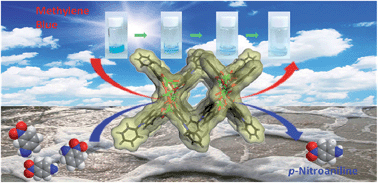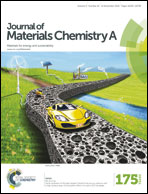A cadmium(ii)-based metal–organic framework for selective trace detection of nitroaniline isomers and photocatalytic degradation of methylene blue in neutral aqueous solution†
Abstract
A robust luminescent metal–organic framework (MOF), Cd–PDA, was solvothermally synthesized and structurally characterized. Cd–PDA has a 3D stable framework decorated with one-dimensional rectangular channels (7.13 × 10.59 Å2). It showed superior sensitivity towards p-nitroaniline compared to other nitroaniline isomers. The detection limit for p-nitroaniline was found to be extremely low, 3.5 ppb in solution, which represents one of the most efficient porous material-based sensors for p-NA. And the sensing mechanism was discussed through FT-IR spectra and molecular force field-based calculations. In addition, the photocatalytic activities of Cd–PDA were also determined by 500 W Xe lamp induced photodegradation of methylene blue (MB) experiments. Cd–PDA has the advantages of excellent catalytic activity, stability, and availability. Along with ease of recyclability, it will be useful in practical applications.


 Please wait while we load your content...
Please wait while we load your content...